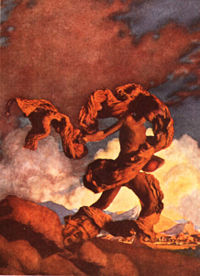- Dragon's teeth (mythology)
-
For other uses, see Dragon's teeth (disambiguation).
In Greek myth, dragon's teeth feature prominently in the legends of the Phoenician prince Cadmus and Jason's quest for the Golden Fleece. In each case, the dragon's teeth, once planted, would grow into fully armed warriors.
Cadmus was the bringer of literacy and civilization, killed the sacred dragon that guarded the spring of Ares. The goddess Athena told him to sow the teeth, from which sprang a group of ferocious warriors called the spartoi. He threw a precious jewel into the midst of the warriors, who turned on each other in an attempt to seize the stone for themselves. The five survivors joined with Cadmus to found the city of Thebes.
Jason obtained the remaining dragon's teeth with the aid of Aeëtes of Colchis. He offered the Golden Fleece to Jason if Jason would sow them into the ground. Jason did this and successfully overcame the warriors with the aid of Medea, who gave him the means to resist fire and steel.
The classical legends of Cadmus and Jason have given rise to the phrase "to sow dragon's teeth." This is used as a metaphor to refer to doing something that has the effect of fomenting disputes, rather akin to the law of unintended consequences.
Cultural references
Dragon's teeth were used in World War II to refer to fortifications intended to slow the advance of mechanized armies.
Dragon's Teeth are also mentioned in Nathaniel Hawthorne's novel The Scarlet Letter The reference is stated in Chapter 6. It states that Pearl, Hester Prynne's daughter never created imaginary friends, but she "seemed always to be sowing broadcast the dragon's teeth, whence sprung a harvest of armed enemies, against whom she rushed to battle."
In John Milton's Aeropagitica, his defence of the liberty of unlicensed printing, Milton argues that books "are as lively and as vigorously productive as those fabulous dragon's teeth; and being sown up and down, may chance to spring up armed men."
Stephen Baxter's novel Evolution includes a segment where 21st century soldiers are placed into suspended animation in hidden bunkers, ready to wake up and fight behind enemy lines if their territory is occupied. In the novel this is referred to as "sowing dragons' teeth".
Dragon's Teeth was also the title of a novel by Upton Sinclair about the rise of the German Nazi Party.
In the film Jason and the Argonauts, the Dragon's Teeth became the Teeth of the Hydra.
An abridged version of the myth was quoted by Chakotay in an episode of Star Trek: Voyager. The episode's title is also "Dragon's Teeth".
In the video game Mass Effect, the Geth enemies impale dead and dying humanoid characters on mechanical spikes, which transform them into zombie-like enemies called "Husks." In-game reference material states that these spikes are colloquially referred to as "Dragon's Teeth."
In The Titan's Curse, Atlas tells one of the mortal henchmen to plant the teeth of the dragon into the soil of the Smithsonian, which sprouted into skeletal warriors, emphasizing the myth.
In the song Pieces of What by MGMT, reference is made to dragon's teeth in the line: "lay my dragon's teeth and shallow water steel, at the Belgian Gates I waited for my meal."
Categories:- Greek mythology
- Mythological objects
Wikimedia Foundation. 2010.

